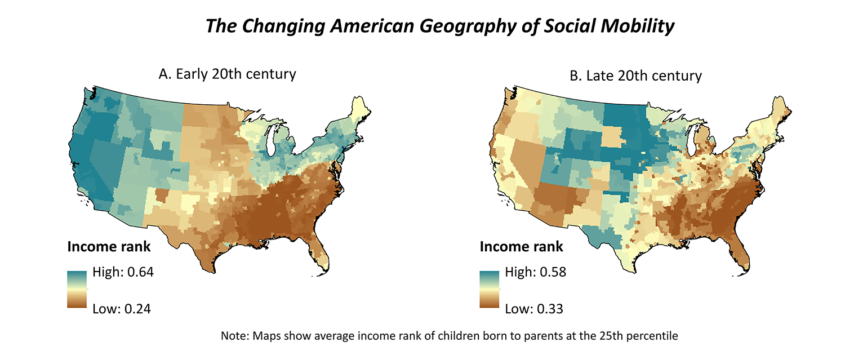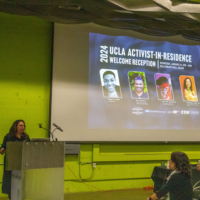Race, Place of Birth Are Key Factors in Americans’ Upward Mobility Children are less likely to earn more than their parents as adults if they are Black or grow up in the South, according to a new study
By Les Dunseith
A new longitudinal study of the geography of upward mobility in the United States shows that regions with high levels of income inequality have suffered from consistently low levels of intergenerational mobility over the last century.
In an article published today by the prestigious Proceedings of the National Academy of Sciences, co-authors Dylan Connor of Arizona State University and Michael Storper of UCLA Luskin discuss findings that include:
- Individuals growing up in urbanized and industrialized regions — such as in the Northeast, Midwest and West — experienced higher levels of intergenerational social mobility in the early 20th century, although this advantage declined over time.
- People born in the South experienced consistently lower levels of social mobility throughout the 20th century.
- Regions with large Black populations that face income inequality have suffered from consistently lower levels of social mobility.
- An individual’s early childhood environment has gained increasing importance over time as a predictor of economic upward mobility in the country. In the early 20th century, for example, proximity to a city with employment opportunities in manufacturing was of greater importance than in today’s economy. Contemporary upward mobility is more likely to depend on educational success.
The authors analyzed location and income data from the U.S. Census for more than 1 million U.S.-born fathers and sons in 1920 and 1940, respectively, to measure regional social mobility in the early 20th century. They compared those findings with contemporary social mobility patterns derived from Internal Revenue Service data for 10 million children from the 1980–1982 birth cohorts and later observed from 2011–2012. Although the newer data capture the experiences of both males and females, the historical data only apply to males.
Why did the authors need to look back 100 years?
“The article’s central concern is intergenerational social mobility — meaning the probability that the children of one generation will or will not achieve a higher socioeconomic status than their parents,” said Storper, a professor of urban planning at the UCLA Luskin School of Public Affairs. Although adult life may take place in a region different from one’s childhood, the region where a person starts life influences factors such as quality of schooling, social support structures and parental income.
“We have to know how the conditions of their childhood might have helped them be both geographically and socially mobile,” he said, “and whether geographical migrants are more socially mobile than stay-at-homes.”
Connor pointed out that understanding changes over time in intergenerational social mobility can provide a sense of how and where society needs to make improvements. Intergenerational change is a slow process, however, and the study needed to compare multiple waves of parents to their adult children at intervals that were 25 years apart.
“To get a sense of how things are changing across generations, we must take a long-term perspective,” said Connor, an assistant professor in Arizona State’s School of Geographical Sciences and Urban Planning.
In recent decades, the Northern Plains went from having one of the lowest rates to among the highest for intergenerational social mobility. One factor was a propensity for people born there to relocate as adults to other parts of the country for better work opportunities, often in sunnier locales such as California and other Western states.
But children born in the South had persistently lower levels of intergenerational social mobility, the study found. Among the factors is “the persistent way that race influences early childhood opportunities, probably by discouraging social consensus around investing in such things as schooling for all, and the way discrimination affects childhood and adult performance,” Storper said.
“This is what we call ‘deep roots’ — or persistent long-term structures impacting social mobility.”
Although many of the leading economic regions of the early 20th century weakened over time as springboards for intergenerational advancement, historical economic inequality within the regions with those deep roots, in contrast, exhibited a more consistent negative association. Correlating factors included high school dropout rates and income inequality.
The Black population share also showed statistical correlation, which the authors say shows the persistent impact of racial subordination, inequality and inadequate schooling on the U.S. landscape of opportunity.
“By social mobility, we are thinking about the degree of upward mobility within the American income/class structure for children who were born into poverty,” said Connor, who noted how the study relates directly to recent momentum around racial inequity and the Black Lives Matter movement. “One of the main concerns is that African American children are both more likely to be born into poverty and also face particularly high barriers to escaping poverty as adults — a point that is very strongly supported by our findings.”
A robust local labor market and access to quality schooling in early life were consistent factors in social mobility across generations and over time, according to the study. Because much of the South continues to lag other regions in terms of schooling and other social influences, major improvements in upward mobility have been slow to develop despite considerable growth in employment and economic output.
The authors also sought to identify and understand other long-term patterns across geographical regions.
“Some areas of the United States have witnessed significant declines in social mobility, while others have had persistently low levels all along. Thus, the contemporary national picture is shaped by both powerful forces of change that reduce intergenerational mobility in some regions and deeply entrenched long-term forces generating persistence in others,” they write in the journal.
Two specific cases stood out to the researchers when they compared data over time.
First, urban areas of the Midwest were comparable to the persistently high-income Northeast and West regions in the early 20th century, but intergenerational social mobility in the region was the third-lowest by century’s end, only slightly above the less urban areas of the South.
Second, the benefits of migration were higher for people leaving the Plains and Mountain regions, and the South to a lesser extent, than for their counterparts who left higher-income regions elsewhere.
“This intuitive pattern is consistent across the century and confirms the role of outmigration in providing a path to upward mobility for people growing up in lower-income places,” the authors wrote.










In order to restores the black communities we must restores the black families! The Solutions to the black conditions are the following: Stop treating each other like shit 2. Two loving parents 3. Two incomes 4. Education 5. Investments, 6. Ownerships 7. Wealth building 8. Health building 9. Proper etiquette 10. Discipline